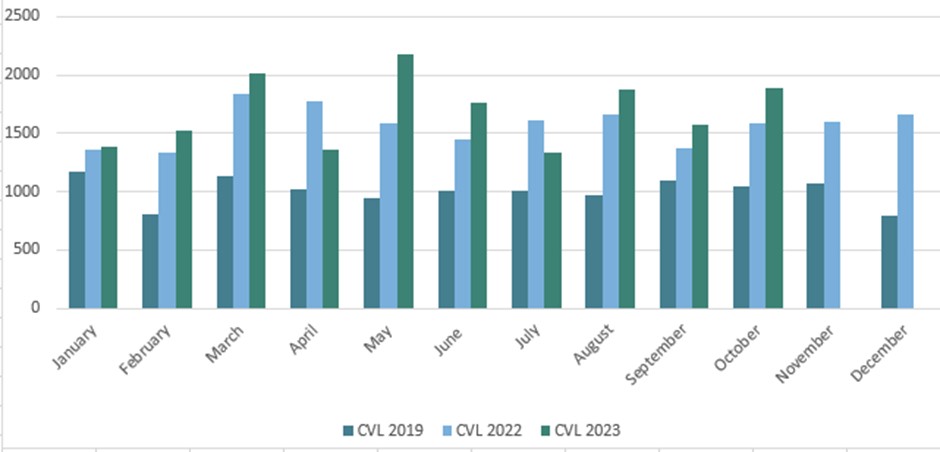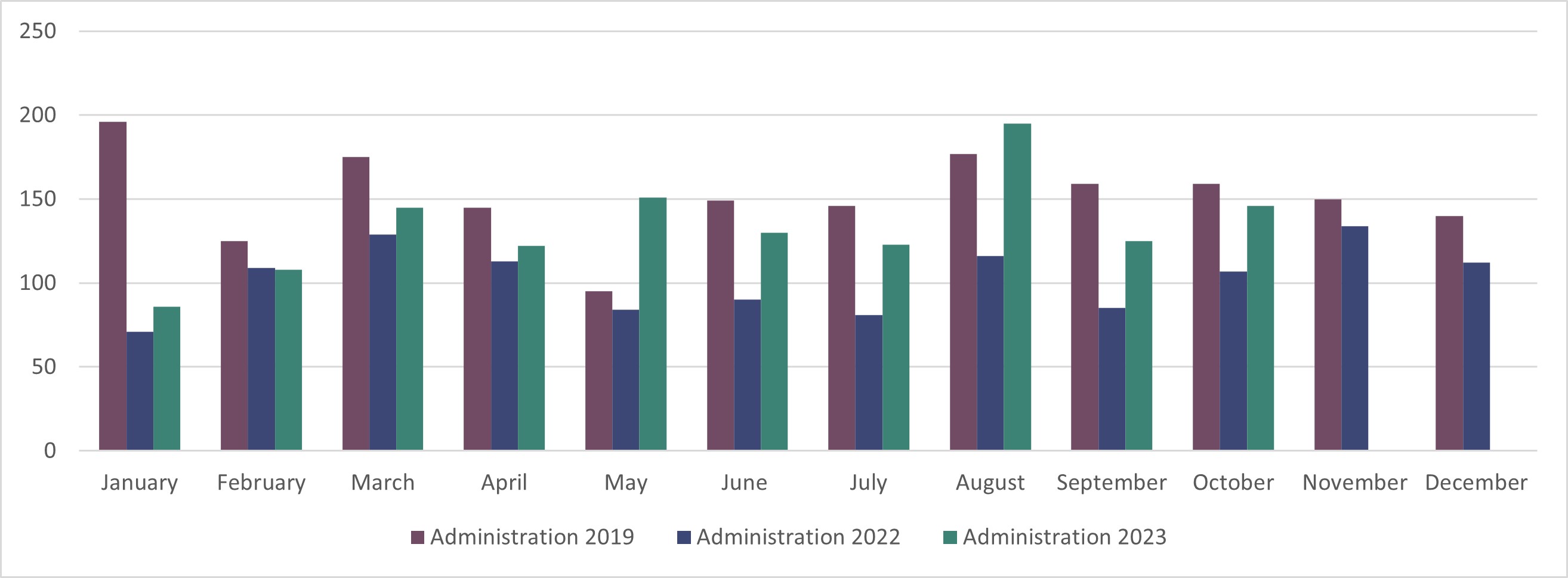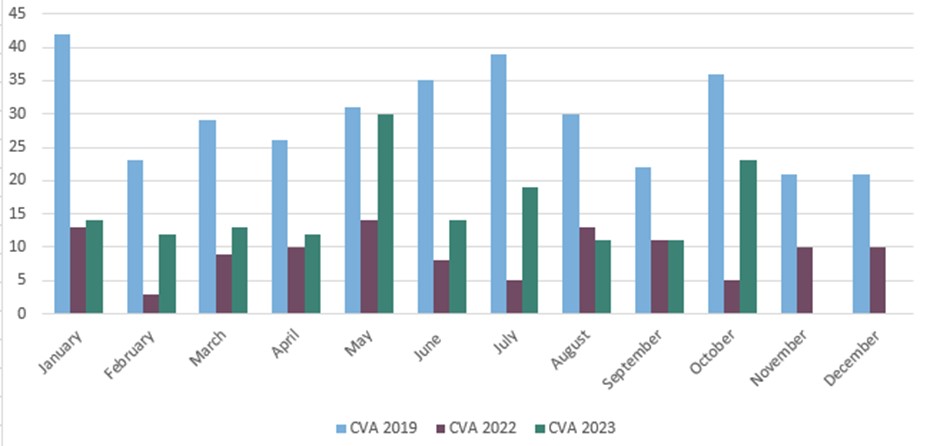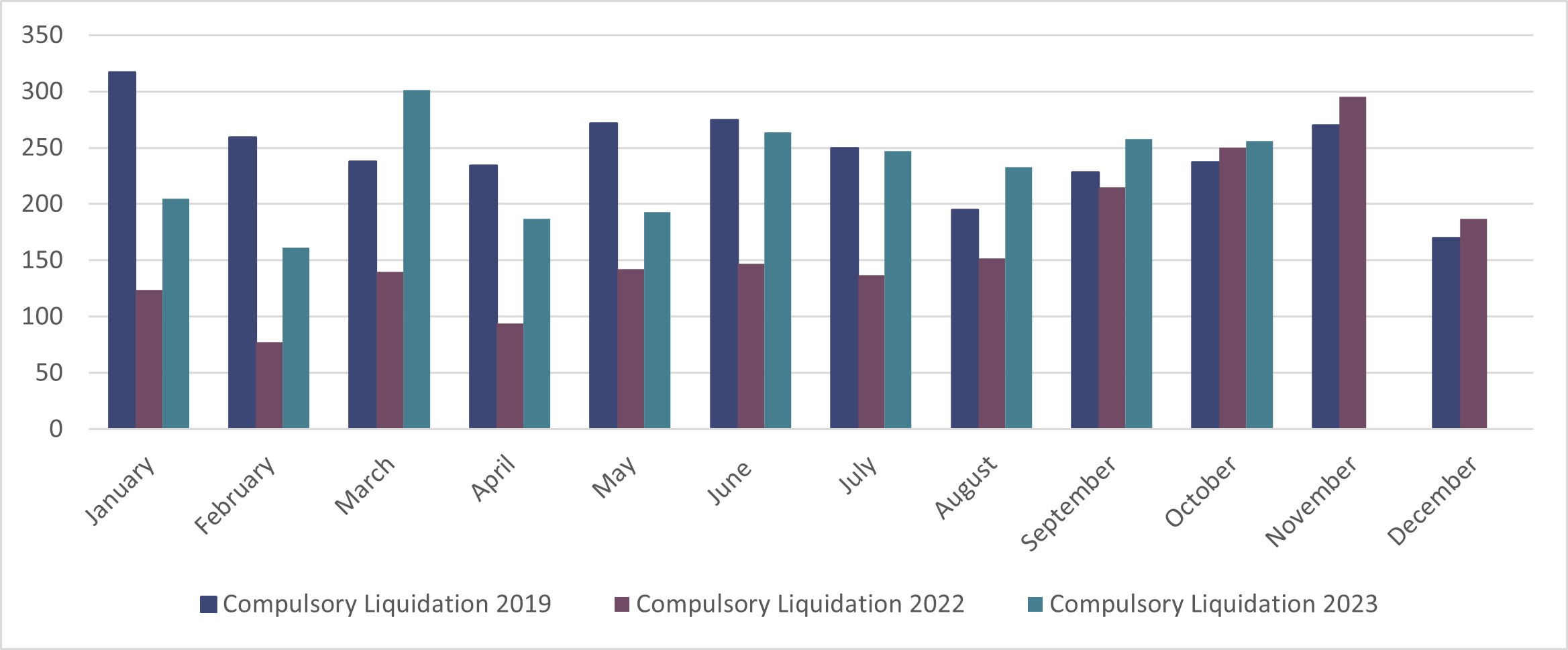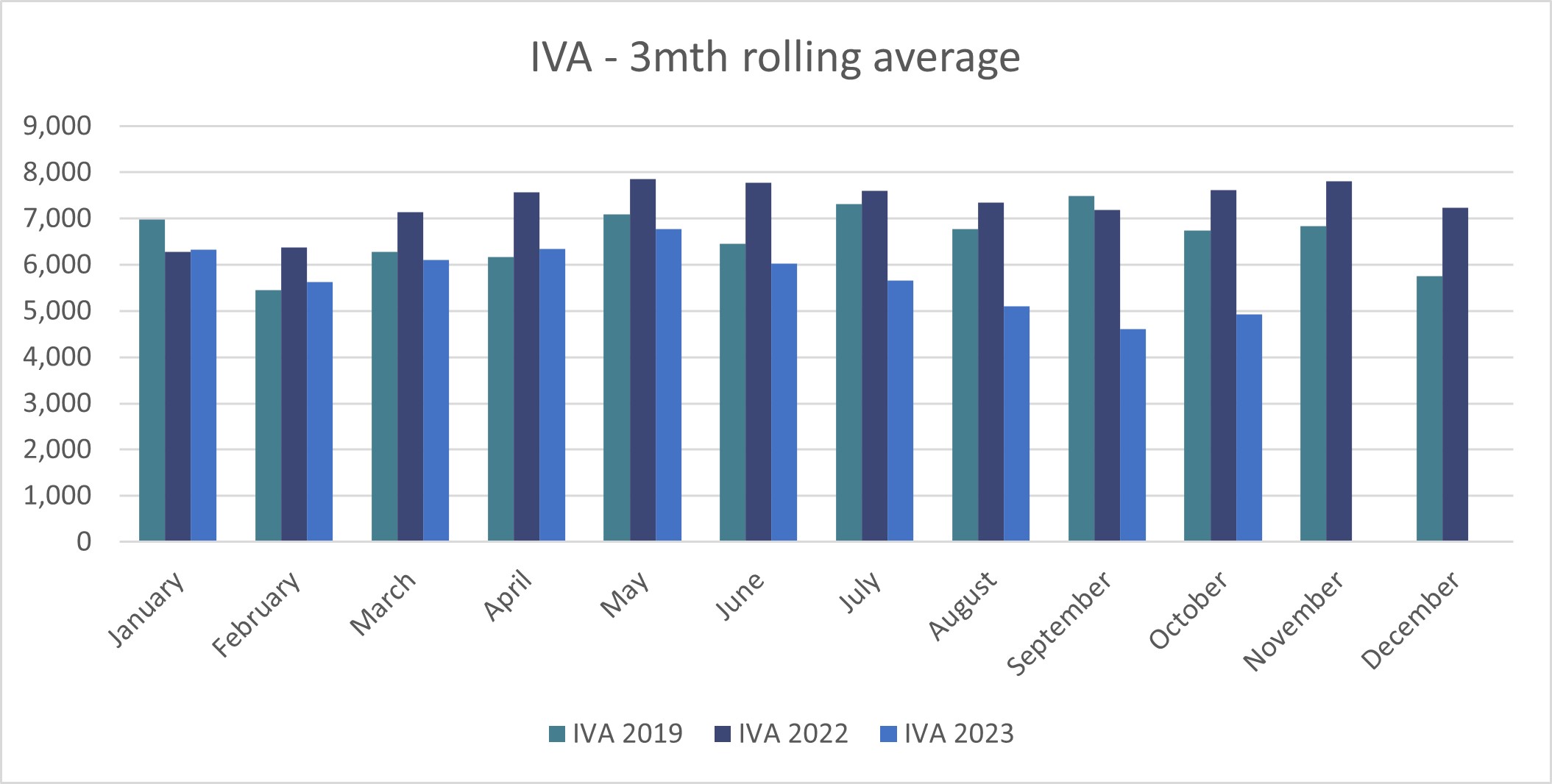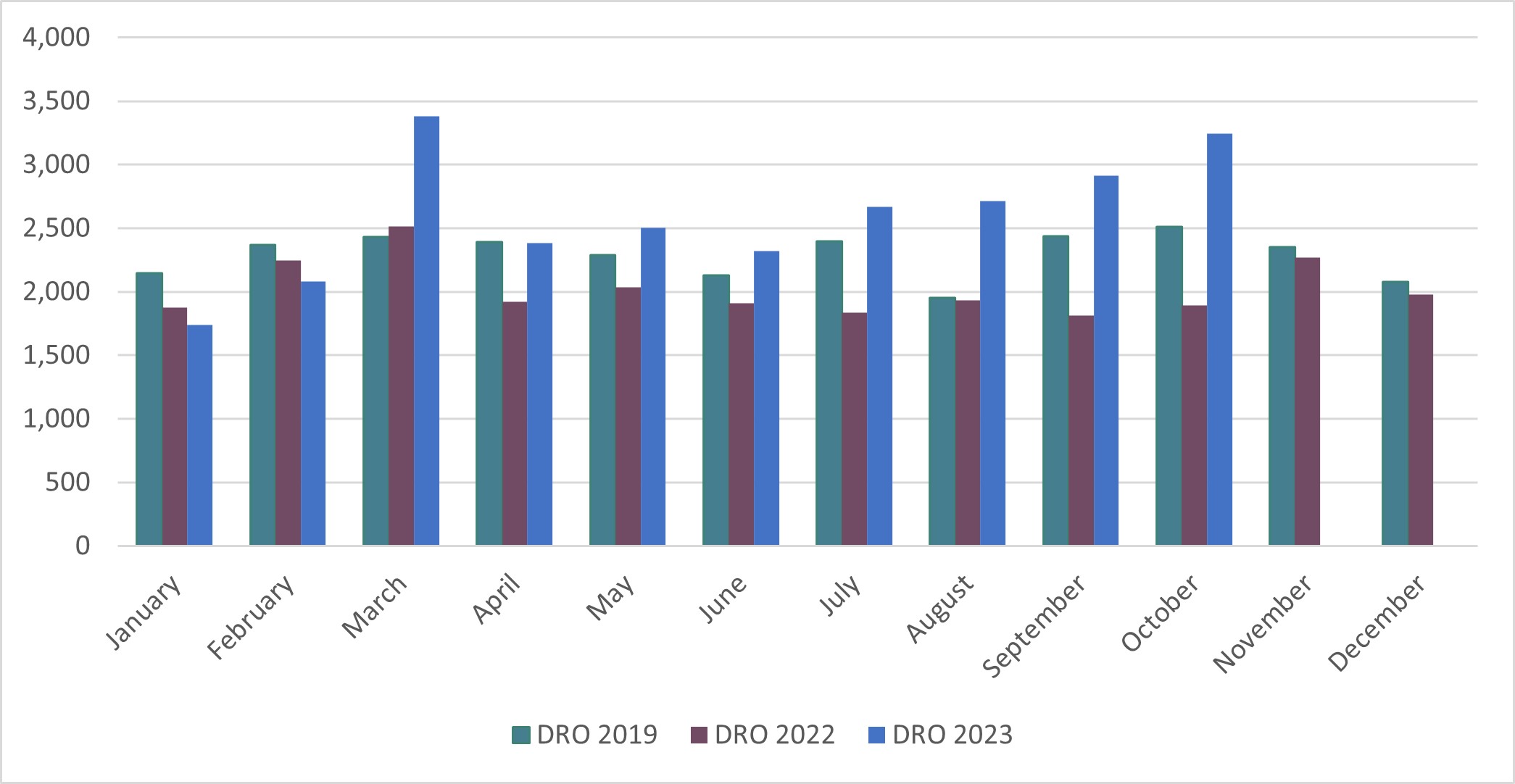
Monthly insolvency statistics – October 2023
Monthly insolvency statistics – October 2023
Corporate Insolvencies
England and Wales
Corporate insolvencies totalled 2,315 in October 2023 and were 18% higher than October 2022 and 57% higher than October 2019.
Creditors Voluntary Liquidations (“CVLs”) totalled 1,889, 19% higher than October 2022 and 81% higher than in (pre-pandemic) October 2019.
There were 146 Administration appointments which is 36% higher than October 2022 but 8% lower than pre-pandemic levels.
There were 23 CVAs in October 2023, over 3.5 times as many as October 2022 but 36% lower than October 2019.
Compulsory Liquidations (“WUCs”) totalled 256, 2% higher than October 2022 and 8% higher than October 2019.
The figures above reflect anecdotal evidence from discussions within the restructuring industry of a continuing trend whereby businesses are facing increasing financial pressure but with fewer options to trade through critical issues.
Scotland
In October 2023, there were 99 company insolvencies registered in Scotland, 21% higher than the number in October 2022. This was comprised of 35 compulsory liquidations, 58 CVLs, 4 administrations and 2 CVAs. There were no receivership appointments.
Historically, the volume of company insolvencies registered in Scotland has been driven by compulsory liquidations. However, during the coronavirus pandemic, around three times as many CVLs as compulsory liquidations were registered. In the first ten months of 2023, CVL numbers remained more than 1.5 times higher than compulsory liquidation numbers.
Northern Ireland
In October 2023, there were 27 company insolvencies registered in Northern Ireland, 80% higher than October 2022. This was comprised of 12 CVLs, 14 compulsory liquidations and one administration. There were no CVAs or receivership appointments.
Personal Insolvencies
England and Wales
Personal insolvency numbers have been on a steady upward curve, driven by interest rates and the cost-of-living crisis.
The significant decline in Individual Voluntary Arrangements (IVA’s) had seen total individual insolvencies fall in recent months, and although there was a slight recovery in October, the overall trend for IVA’s remains downwards. There have been increases in Debt Relief Orders and (less markedly) in Bankruptcy Orders in the same period, which has created a flat line trend since the pandemic, punctuated by monthly peaks and troughs.
There were 7,637 Breathing Space (BS) registrations in October, which is significantly higher than the number registered in October 2022 (6,230). October’s Mental Health BS application figure of 128, is also an increase on the 12-month average.
With clamping down on poor advice, and better signposting by the regulated debt advice sector, we expect the BS monthly figure to show a continued steady upward trend. As BS is merely a pause in the debt settlement process, it would not be surprising to also see the DRO, bankruptcy and IVA numbers rise slightly each month, once the BS period expires for these individuals.
There were only 5,933 Individual Voluntary Arrangements registered in October, which is on par with the monthly average of around 5,993 in the previous 12 months. As better regulated advice begins to take effect, coupled with the increased BS applications, IVA numbers so far in 2023 have been notably lower than the record high numbers in 2022.
In 2019, there were 2,289 Debt Relief Orders (DRO’s) a month on average, and following the changes in entry criteria from June 2021, surprisingly they had only averaged around 2,141 per month. The October figure of 3,245 continues the steady uptick in DRO’s, probably being the option of choice to those who may previously have been badly advised into an IVA.
A current DRO would have previously been a no-asset bankruptcy and therefore, the record low bankruptcy numbers of 2021/22 were of no real surprise. The average monthly bankruptcy numbers in 2019 were 1,395, made up of 1,134 debtor’s applications and 261 creditor petitions.
The stark decrease from that period to the current numbers is clear against the last 12-month averages of 597 bankruptcies, made up of an average of 476 debtor’s applications and 121 creditor petitions per month.
In October, there were 703 bankruptcies, against a 2022 average of 557 per month. We expect the bankruptcy numbers to steadily pick up, showing a more marked increase into 2024.
In October, 553 bankruptcy applications were instigated by indebted individuals – a slight increase from the 12-month average of 481.
Bankruptcy petitions will undoubtedly have to be issued by creditors to recover debts incurred during and since the pandemic as a result of current economic pressures. In October, there were 150 creditors’ petitions, which continues the rise on the preceding 12 months’ average of 127.
We expect to see creditor-driven bankruptcies begin to steadily increase further into 2024, led by HMRC in the recovery of unpaid tax liabilities. The volume of bankruptcy petitions will be driven by resource availability at HMRC, and by the ability of the Court system to manage the process.
Northern Ireland
In October 2023 there were 125 individual insolvencies in Northern Ireland, 22% lower than in October 2022. This consisted of 94 IVAs, 7 DROs and 24 bankruptcies.


